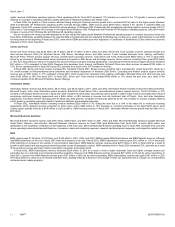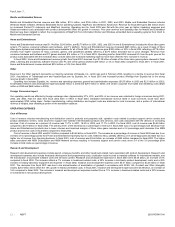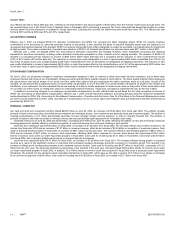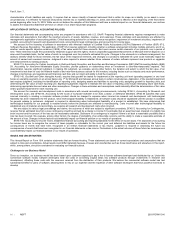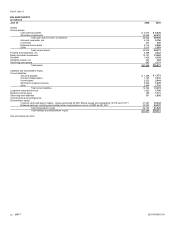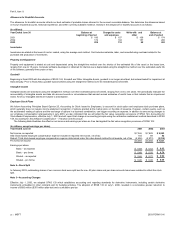Microsoft 2003 Annual Report Download - page 30
Download and view the complete annual report
Please find page 30 of the 2003 Microsoft annual report below. You can navigate through the pages in the report by either clicking on the pages listed below, or by using the keyword search tool below to find specific information within the annual report.Part II, Item 7,
MSFT 2003 FORM 10-K
17 /
innovative software that is useful, reliable, and compatible with other software and hardware. In recent years, there has been a growing challenge to the
commercial software model, often referred to as the Open Source model. Under the Open Source model, software is produced by loosely associated groups of
unpaid programmers, and the resulting software and the intellectual property contained therein is licensed to end users at substantially no cost. The most notable
example of Open Source software is the Linux operating system. While we believe that our products provide customers with significant advantages in security and
productivity, and generally have a lower total cost of ownership than Open Source software, the popularization of the Open Source model continues to pose a
significant challenge to our business model, including recent efforts by proponents of the Open Source model to convince governments worldwide to mandate the
use of Open Source software in their purchase and deployment of software products. To the extent the Open Source model gains increasing market acceptance,
sales of our products may decline, we may have to reduce the prices we charge for our products, and revenues and operating margins may consequently decline.
Intellectual Property Rights
We defend our intellectual property rights, but unlicensed copying and use of software and intellectual property rights represents a loss of revenue to us. While this
adversely affects U.S. revenue, the impact on revenue from outside the United States is more significant, particularly in countries where laws are less protective of
intellectual property rights. Throughout the world, we actively educate consumers about the benefits of licensing genuine products and educate lawmakers about
the advantages of a business climate where intellectual property rights are protected. However, continued educational and enforcement efforts may not affect
revenue positively and further deterioration in compliance with existing legal protections or reductions in the legal protection for intellectual property rights of
software developers could adversely affect revenue.
From time to time we receive notices from others claiming we infringe their intellectual property rights. The number of these claims may grow. Responding to
these claims may require us to enter into royalty and licensing agreements on unfavorable terms, require us to stop selling or to redesign affected products, or to
pay damages or to satisfy indemnification commitments with our customers.
We have made and expect to continue making significant expenditures to acquire the use of technology and intellectual property rights, including via cross-
licenses of broad patent portfolios.
New Products and Services
We have made significant investments in research, development and marketing for new products, services and technologies, including Microsoft .NET, Xbox,
business applications, MSN, mobile and wireless technologies, and television. Significant revenue from new product and service investments may not be achieved
for a number of years, if at all. Moreover, these products and services may never be profitable, and even if they are profitable, operating margins for these
businesses are not expected to be as high as the margins historically experienced by us.
Litigation
As discussed in Note 20 – Contingencies of the Notes to Financial Statements, we are subject to a variety of claims and lawsuits. While we believe that none of
the litigation matters in which we are currently involved will have a material adverse impact on our financial position or results of operations, it is possible that one
or more of these matters could be resolved in a manner that ultimately would have a material adverse impact on our business, and could negatively impact our
revenues, operating margins, and net income.
Declines in Demand for Software
If overall market demand for PCs, servers and other computing devices declines significantly, or consumer or corporate spending for such products declines, our
revenue will be adversely affected. Additionally, our revenues would be unfavorably impacted if customers reduce their purchases of new software products or
upgrades to existing products because new product offerings are not perceived as adding significant new functionality or other value to prospective purchasers. A
significant number of customers purchased license agreements providing upgrade rights to specific licensed products prior to the transition to Licensing 6.0 in July
2002. These agreements will expire in 2004 and 2005 and the rate at which such customers renew these contracts could adversely affect future revenues. We are
also committing significant investments in the next release of the Windows operating system, codenamed Longhorn. If this system is not perceived as offering
significant new functionality or value to prospective purchasers, our revenues and operating margins could be adversely affected.
Product Development Schedule
The development of software products is a complex and time-consuming process. New products and enhancements to existing products can require long
development and testing periods. Significant delays in new product releases or significant problems in creating new products, particularly any delays in the
Longhorn operating system, could adversely affect our revenues.
General Economic and Geo-Political Risks
Continued softness in corporate information technology spending or other changes in general economic conditions that affect demand for computer hardware or
software could adversely affect our revenues. Terrorist activity and armed conflict pose the additional risk of general economic disruption and could require
changes in our international operations and security arrangements, thus increasing our operating costs. These conditions lend additional uncertainty to the timing
and budget for technology investment decisions by our customers.
Competition
We continue to experience intensive competition across all markets for our products and services. These competitive pressures may result in decreased sales
volumes, price reductions, and/or increased operating costs, such as for marketing and sales incentives, resulting in lower revenues, gross margins and operating
income.
Taxation of Extraterritorial Income
In August 2001, a World Trade Organization (“WTO”) dispute panel determined that the tax provisions of the FSC Repeal and Extraterritorial Income Exclusion Act
of 2000 (“ETI”) constitute an export subsidy prohibited by the WTO Agreement on Subsidies






